Pheidole lamia
| Pheidole lamia | |
|---|---|

| |
| Scientific classification | |
| Kingdom: | Animalia |
| Phylum: | Arthropoda |
| Class: | Insecta |
| Order: | Hymenoptera |
| Family: | Formicidae |
| Subfamily: | Myrmicinae |
| Tribe: | Attini |
| Genus: | Pheidole |
| Species: | P. lamia |
| Binomial name | |
| Pheidole lamia Wheeler, W.M., 1901 | |
From Wilson (2003): P. lamia is a reclusive, soil-nesting species. Feener (1981) found that the species, which is seemingly rare because of its infrequent encounters with entomologists, is actually quite abundant at the type locality (Austin, Texas), at least in the secondary oak-hackenberry woodland of the Brackenridge Field Laboratory. In both Florida and Texas mature colonies each contain 500-1500 minor workers, and a much smaller number of major workers. Nests are constructed directly in soil beneath leaf litter, and thus are unusually difficult to find. Buren et al. (1977), studying Florida colonies in laboratory nests, found that the phragmotic majors use their bulldozer-like heads effectively in defense against marauding thief ants of the genus Solenopsis. At Austin, minor workers were observed foraging around the clock in warm weather (Feener 1981).
| At a Glance | • Phragmotic |
Identification
See the description in the nomenclature section.
Keys including this Species
Distribution
Northern Florida west to at least Austin, Texas. (Wilson 2003)
Latitudinal Distribution Pattern
Latitudinal Range: 33.816305° to 19.31777°.
| North Temperate |
North Subtropical |
Tropical | South Subtropical |
South Temperate |
- Source: AntMaps
Distribution based on Regional Taxon Lists
Nearctic Region: United States (type locality).
Distribution based on AntMaps
Distribution based on AntWeb specimens
Check data from AntWeb
Countries Occupied
| Number of countries occupied by this species based on AntWiki Regional Taxon Lists. In general, fewer countries occupied indicates a narrower range, while more countries indicates a more widespread species. |

|
Estimated Abundance
| Relative abundance based on number of AntMaps records per species (this species within the purple bar). Fewer records (to the left) indicates a less abundant/encountered species while more records (to the right) indicates more abundant/encountered species. |

|
Biology
Castes
Worker
Minor
Images from AntWeb
   
| |
| Worker. Specimen code casent0104788. Photographer April Nobile, uploaded by California Academy of Sciences. | Owned by UCDC, Davis, CA, USA. |
   
| |
| Worker. Specimen code casent0172696. Photographer April Nobile, uploaded by California Academy of Sciences. | Owned by FSCA, Gainesville, FL, USA. |
 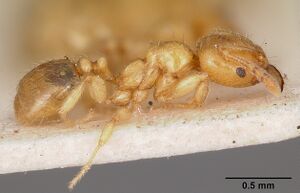   
| |
| Worker. Specimen code casent0104698. Photographer April Nobile, uploaded by California Academy of Sciences. | Owned by AMNH, New York, NY, USA. |
Major
         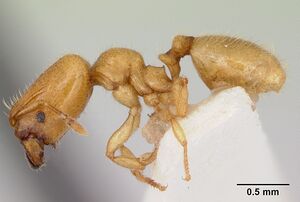    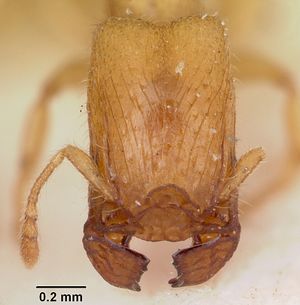 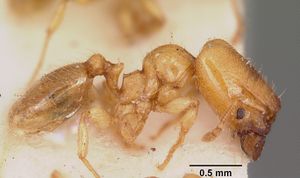   
| |
| . | Owned by Museum of Comparative Zoology. |
Male
   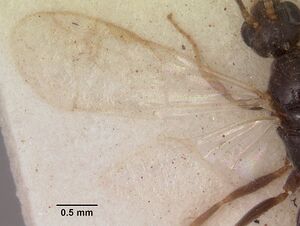 
| |
| . | |
Nomenclature
The following information is derived from Barry Bolton's Online Catalogue of the Ants of the World.
- lamia. Pheidole lamia Wheeler, W.M. 1901b: 534, fig. 11 (s.w.) U.S.A. See also: Feener, 1981: 269; Wilson, 2003: 546.
Unless otherwise noted the text for the remainder of this section is reported from the publication that includes the original description.
Description
From Wilson (2003): DIAGNOSIS A typical member of the lamia group: the major has a phragmotic head, with the anterior portion incorporating the clypeus and mandibles flattened (truncated), and deep antennal scrobes. This species is easily distinguished from the other members of the lamia group (Pheidole colobopsis, Pheidole pelor, Pheidole truncula) by the very elongate head of the major and Sculpturing of its head, which consists exclusively of parallel longitudinal carinulae that extend almost all the way to the occiput; and by the reduction of the propodeal spine in the major and minor to denticles.
MEASUREMENTS (mm) Lectotype major: HW 0.62, HL 0.92, SL 0.37, EL 0.00, PW 0.00. Paralectotype minor: HW 0.44, HL 0.52, SL 0.48, EL 0.06, PW 0.30.
COLOR Major: concolorous yellow, with a faint reddish tinge.
Minor: concolorous yellow.
Figure. Upper: lectotype, major. Lower: paralectotype, minor. Scale bars = 1 mm.
Type Material
TEXAS: Austin (col. W. M. Wheeler). Museum of Comparative Zoology and American Museum of Natural History - as reported in Wilson (2003)
Etymology
Gr lamia, a witch or monster that sucks blood, obviously an overstatement in reference to the bizarre head of the major. (Wilson 2003)
References
- Wilson, E. O. 2003. Pheidole in the New World: A dominant, hyperdiverse ant genus. Harvard University Press, Cambridge, MA. (page 546, fig. major, minor described)
- Buren, W. F., M. A. Naves, and T. C. Carlysle. 1977. False phragmosis and apparent specialization for subterranean warfare in Pheidole lamia Wheeler (Hymenoptera: Formicidae). J. Ga. Entomol. Soc. 12: 100–108.
- Feener, D. H., Jr. 1981. Notes on the biology of Pheidole lamia (Hymenoptera: Formicidae) at its type locality (Austin, Texas). J. Kans. Entomol. Soc. 54: 269-277 (page 269, see also)
- Gregg, R. E. 1956. An extension of range for the ant, Pheidole lamia Wheeler (Hymenoptera: Formicidae). Entomological News 67:37-39. [1956-02-03]
- MacGown, J.A., Booher, D., Richter, H., Wetterer, J.K., Hill, J.G. 2021. An updated list of ants of Alabama (Hymenoptera: Formicidae) with new state records. Transactions of the American Entomological Society 147: 961-981 (doi:10.3157/061.147.0409).
- Wheeler, W. M. 1901c. The compound and mixed nests of American ants. Part II. The known cases of social symbiosis among American ants. Am. Nat. 35: 513-539 (page 534, fig. 11 soldier, worker described)
References based on Global Ant Biodiversity Informatics
- Dattilo W. et al. 2019. MEXICO ANTS: incidence and abundance along the Nearctic-Neotropical interface. Ecology https://doi.org/10.1002/ecy.2944
- Deyrup M., C. Johnson, G. C. Wheeler, J. Wheeler. 1989. A preliminary list of the ants of Florida. Florida Entomologist 72: 91-101
- Deyrup, M. 2003. An updated list of Florida ants (Hymenoptera: Formicidae). Florida Entomologist 86(1):43-48.
- Feener D. H. 1981. Notes on the biology of Pheidole lamia (Hymenoptera: Formicidae) at its type locality (Austin, Texas). Journal of the Kansas Entomological Society 54(2): 269-277.
- Graham, J.H., A.J. Krzysik, D.A. Kovacic, J.J. Duda, D.C. Freeman, J.M. Emlen, J.C. Zak, W.R. Long, M.P. Wallace, C. Chamberlin-Graham, J.P. Nutter and H.E. Balbach. 2008. Ant Community Composition across a Gradient of Disturbed Military Landscapes at Fort Benning, Georgia. Southeastern Naturalist 7(3):429-448
- Gregg R. E. 1956. An extension of range for the ant, Pheidole lamia Wheeler (Hymenoptera: Formicidae). Entomological News 67: 37-39.
- Gregg R. E. 1959. Key to the species of Pheidole (Hymenoptera: Formicidae) in the United States. Journal of the New York Entomological Society 66: 7-48.
- Hill J.G. & Brown R. L. 2010. The Ant (Hymenoptera: Formicidae) Fauna of Black Belt Prairie Remnants in Alabama and Mississippi. Southeastern Naturalist. 9: 73-84
- Jusino-Atresino R., and S. A. Phillips, Jr. 1992. New ant records for Taylor Co., Texas. The Southern Naturalist 34(4): 430-433.
- Moody J. V., and O. F. Francke. 1982. The Ants (Hymenoptera, Formicidae) of Western Texas Part 1: Subfamily Myrmicinae. Graduate Studies Texas Tech University 27: 80 pp.
- Morrison, L.W. 2002. Long-Term Impacts of an Arthropod-Community Invasion by the Imported Fire Ant, Solenopsis invicta. Ecology 83(8):2337-2345
- Naves M. A. 1985. A monograph of the genus Pheidole in Florida, USA (Hymenoptera: Formicidae). Insecta Mundi 1: 53-90
- O'Keefe S. T., J. L. Cook, T. Dudek, D. F. Wunneburger, M. D. Guzman, R. N. Coulson, and S. B. Vinson. 2000. The Distribution of Texas Ants. The Southwestern Entomologist 22: 1-92.
- Smith M. R. 1931. An additional annotated list of the ants of Mississippi (Hym.: Formicoidea). Entomological News 42: 16-24.
- Smith M. R. 1936. A list of the ants of Texas. Journal of the New York Entomological Society 44: 155-170.
- Wheeler W. M. 1901. The compound and mixed nests of American ants. Part II. The known cases of social symbiosis among American ants. American Naturalist. 35: 513-539.
- Wheeler W. M. 1908. The ants of Texas, New Mexico and Arizona. (Part I.). Bulletin of the American Museum of Natural History 24: 399-485.
- Wheeler, G.C. and J. Wheeler. 1985. A checklist of Texas ants. Prairie Naturalist 17:49-64.
- Wilson, E.O. 2003. Pheidole in the New World: A Dominant, Hyperdiverse Genus. Harvard University Press



